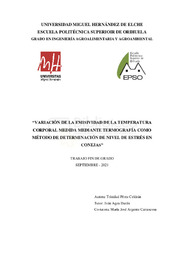Por favor, use este identificador para citar o enlazar este ítem:
https://hdl.handle.net/11000/25985Registro completo de metadatos
| Campo DC | Valor | Lengua/Idioma |
|---|---|---|
| dc.contributor.advisor | Agea Durán, Iván | - |
| dc.contributor.advisor | Argente Carrascosa, María José | - |
| dc.contributor.author | Pérez Celdrán, Trinidad | - |
| dc.date.accessioned | 2022-02-25T12:50:40Z | - |
| dc.date.available | 2022-02-25T12:50:40Z | - |
| dc.date.created | 2021-09 | - |
| dc.identifier.uri | http://hdl.handle.net/11000/25985 | - |
| dc.description.abstract | Un experimento de selección divergente por variabilidad residual del tamaño de camada en conejos se ha llevado a cabo durante 12 generaciones, obteniéndose una línea homogénea, línea Low, y otra heterogénea, línea High. El estrés causa un incremento de temperatura corporal y se propone la termografía infrarroja como técnica útil para identificar cambios en la emisividad de temperatura. El objetivo de este estudio es estudiar la respuesta correlacionada de la selección por variabilidad residual del tamaño de camada al parto en la emisividad de temperatura medida en ojo tras la monta natural. La línea Low presentó un incremento de temperatura a los 5 min del estímulo estresante, que se mantuvo hasta los 60 min (de 35,63 ºC a 36,28 ºC). La línea High presentó un incremento de temperatura mayor que la línea Low a 30 min (de 35,82 ºC a 36,97 ºC). Palabras clave: conejo, estrés, selección, temperatura, termografía. | es_ES |
| dc.description.abstract | A divergent selection for litter size residual variability has been carried out in rabbits during 12 generations, achieving one homogeneous line, Low line, and other heterogeneous line, High line. Stress causes an increase in core body temperature and infrared thermography is proposed as a useful technique for identifying changes in body temperature emissivity. The aim of this work is to study the correlated response to selection for litter size residual variability in body temperature emissivity at natural mating, measured on the eyeball. The Low line showed an increase in temperature 5 min after the stressful stimulus, which was maintained until 60 min (from 35.63 ºC to 36.28 ºC). The High line presented a higher temperature increase than the Low line at 30 min (from 35.82 ºC to 36.97 ºC). | es_ES |
| dc.format | application/pdf | es_ES |
| dc.format.extent | 45 | es_ES |
| dc.language.iso | spa | es_ES |
| dc.publisher | Universidad Miguel Hernández de Elche | es_ES |
| dc.rights | info:eu-repo/semantics/openAccess | es_ES |
| dc.rights | Attribution-NonCommercial-NoDerivatives 4.0 Internacional | * |
| dc.rights.uri | http://creativecommons.org/licenses/by-nc-nd/4.0/ | * |
| dc.subject | Conejo | es_ES |
| dc.subject | Termografía | es_ES |
| dc.subject.other | CDU::6 - Ciencias aplicadas::63 - Agricultura. Silvicultura. Zootecnia. Caza. Pesca | es_ES |
| dc.title | Variación de la emisividad de la temperatura corporal medida mediante termografía como método de determinación de nivel de estrés en conejas | es_ES |
| dc.type | info:eu-repo/semantics/bachelorThesis | es_ES |

Ver/Abrir:
TFG Perez Celdran, Trinidad.pdf
597,52 kB
Adobe PDF
Compartir:
 La licencia se describe como: Atribución-NonComercial-NoDerivada 4.0 Internacional.
La licencia se describe como: Atribución-NonComercial-NoDerivada 4.0 Internacional.
.png)